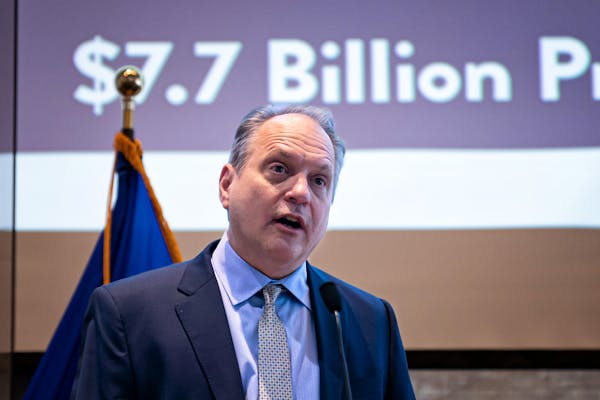More than 2.7 million Minnesota households would get checks of $175 or $350 from the state under a spending plan Gov. Tim Walz unveiled Thursday, with money channeled to front-line workers and caregivers as well.
The DFL governor also wants to repay the state's unemployment insurance debt, a move that has bipartisan support and would prevent a potential large jump in payroll taxes for employers.
"Minnesotans want to see results. They want to see things that make sense. They want this surplus to come to their pockets, make their lives easier, reduce their costs and invest for things that go forward," the governor said during a news conference at Minneapolis Community and Technical College, where he highlighted the first of several pieces of a supplemental budget plan he will unveil over the next week.
The state has a projected $7.7 billion budget surplus, although that prediction could change when economists and budget officials provide an update next month. The unprecedented scale of the expected surplus has opened the door for state leaders to consider sizable spending to supplement the $52 billion two-year budget they approved last year.
Walz's proposal Thursday focused on expanding economic opportunities and included what he called "Walz checks," a nod to former Gov. Jesse Ventura's "Jesse checks." In 2000, the one-time sales tax rebate came out to about $600 per person.
Republican legislators quickly derided Walz's idea of the one-time checks, which would give payments of $175 to single tax filers earning up to $164,400 and $350 to married couples who file jointly and make $273,470 or less.
"Walz checks are nothing more than an election year gimmick, and it will barely cover the inflationary costs of everyday necessities. We'll propose permanent, ongoing, targeted tax relief for working Minnesotans so they see savings every single year," Senate Majority Leader Jeremy Miller, R-Winona, said in a statement.
Walz's proposal would also expand some tax cuts for families with children in child care and school, allowing more people to qualify for the Dependent Care Credit and Minnesota's K-12 Education Credit.
Minnesota Management and Budget Commissioner Jim Schowalter said state leaders need to be cautious about the scale of any ongoing tax cuts or rebates.
"The governor and lieutenant governor are committed to make sure that we are staying inside our projections ... that we can sustain our promises going into the future. That's why some of the money and some of the announcements you are seeing today are really one-time in nature," Schowalter said Thursday.
With a budget for the next two years already in place, lawmakers and Walz don't need to reach a deal on further spending but are hoping to find common ground on some measures.
Leaders on both sides of the aisle have said they want to replenish the state's unemployment insurance trust fund, which was depleted during the pandemic, and repay the state's debt to the federal government for covering unemployment payments. Walz proposed more than $2.7 billion for that purpose.
"There is strong, bipartisan agreement with Gov. Walz to repay the unemployment insurance trust fund, and protect businesses from an unnecessary and harmful tax increase. With a $7.7 billion surplus, the money is there, and we should do it week one so we can give certainty to our businesses and prevent it from being held hostage for other unrelated issues," House Minority Leader Kurt Daudt, R-Crown, said in a statement.
Walz's economic package also included $1 billion for front-line workers, from people working in health care or long-term care facilities to child-care workers, grocery store staff and retail employees. An estimated 667,000 workers would get $1,500 payments under that proposal.
Another $115 million would go toward supporting Minnesota's caregiver workforce, including people working with older adults, individuals with disabilities and people who are homeless. And State Budget Director Ahna Minge said they aim to spend $66 million over three years on boosting the state's health care workforce, including supporting tuition-free paths to get more people into that field.
The economic security package touched on a number of other areas, from unspecified investments in higher education to $170 million for expanded broadband access to more money for the state's Weatherization Assistance Program to lower people's energy bills.
On Thursday the DFL majority in the House, like Walz, held a news conference on their vision for economic security legislation.
"Despite the fact that there's a rapidly improving economy families aren't feeling like that," said House Speaker Melissa Hortman, DFL-Brooklyn Park. "People feel like they can't get ahead. They want jobs with better wages, they want more safety on the job, and they want to be treated with dignity and respect in the workplace."
If legislators put $2.7 billion toward eliminating the state's unemployment insurance trust fund debt and preventing increased payroll taxes for employers, Hortman said her caucus wants to mirror that with spending on workers. They proposed spending nearly $1.7 billion to start and run a paid family and medical leave program for two years, and boosting spending on front-line worker bonuses from $250 million to $1 billion.
Democrats also called for more spending on housing, broadband and earned sick and safe time.
The governor is expected to release two additional pieces of his budget plan next week, which his office described as focused on children and families and protecting people's health and safety.
The $7.7 billion surplus estimate that is the basis for the various spending plans was based in part on a forecast from macroeconomic consultant IHS Markit that was created before the emergence of the omicron variant. The firm had assumed the rate of infection would continue to recede after the delta variant, and the impact of the latest COVID case surge on the state budget remains to be seen.
